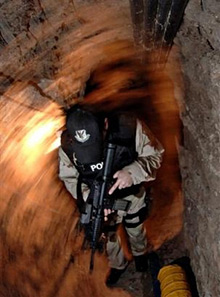 |
 |
 |
 Technology News | January 2006 Technology News | January 2006  
Technology Ineffective Foil to Tunnels Under U.S.-Mexico Border
 Elliot Spagat - Associated Press Elliot Spagat - Associated Press


| | A U.S. Immigration and Customs Enforcement agent comes up out of a cross border tunnel leading from Mexico into the U.S. on Monday, Jan. 30, 2006, in San Diego. (AP/Denis Poroy) |
A U.S. government effort to find tunnels used to smuggle drugs from Mexico into the United States with ground-penetrating radar and other high-tech gear has had little success.

Human intelligence has proven to be the most effective method to find secret passageways. Case in point: Last week's discovery of the longest tunnel ever found along the border resulted from a tip.

The Department of Homeland Security said Monday that a Mexican man, Carlos Cardenas Calvillo, was arrested in connection with the 2,400-foot tunnel, which went as deep as 90 feet and was about 5 feet in height and 5 feet wide. Boxes of marijuana were found on the Mexican and U.S. sides of the tunnel, authorities said.

Cardenas, charged with conspiracy to possess with intent to distribute a controlled substance, appeared before a federal magistrate judge Monday afternoon but did not enter a plea. A bail hearing was set for Wednesday, when the government will seek to continue holding him without bail.

"The problem is the technology picks up some kind of anomaly or variation of soil," said Lauren Mack, a spokeswoman for U.S. Immigration and Customs Enforcement. "We go in with big backhoes and bulldozers, we spend all day doing it, and all we hit is rock or water tables."

That's what happened earlier this month when high-tech gear alerted authorities to a possible tunnel near Boulevard, a hamlet about 60 miles east of San Diego along the Mexican border. A full day of digging turned up nothing.

"It's not there yet," Mack said. "What we've seen so far just hasn't proven itself to be effective."

Using technology to spot tunnels along the U.S.-Mexico border is daunting because it spans nearly 2,000 miles, experts say. U.S. authorities have declined to say much about the high-tech gear that they've tried, saying it may tip off smugglers.

"It's a needle-in-a-haystack problem," said Don Steeples, a geophysics professor at Kansas University who has worked on tunnel detection for 20 years. "In this case, we don't even know where the haystack is."

In late 2003, University of Oklahoma experts began using ground-penetrating radar to help Homeland Security locate tunnels in California's Imperial Valley. The radar led U.S. officials to a dirt road behind a low-income apartment building in Calexico, about 120 miles east of San Diego. In April 2004, officials drilled 20-foot holes behind the building and only hit a water shaft.

Nearly a year later, authorities discovered a nearby tunnel, thanks to a radar, a video-equipped robot, a drug-sniffing dog, and human intelligence, authorities said. That passage - 200 yards long, 3 feet wide and 5 feet high - went from Mexicali, Mexico, to a well-landscaped house in Calexico. It had a concrete floor, wood beam supports, ventilation and fiberglass walls.

The tunnels appear to be concentrated on Mexico's border with California and Arizona - 21 have been discovered in the two states since Sept. 11, 2001, and 15 during the previous 11 years. Four have been found this month between Tijuana and San Diego.

In July, authorities reported the first secret tunnel along the U.S.-Canadian border. The passage, which was reinforced with ribbed steel bars and wood supports, linked a Quonset hut in Langley, British Columbia, to a living room in Lynden, Wash.

Many are found by sheer luck. Last week, a Border Patrol vehicle hit a sinkhole near San Diego's San Ysidro port of entry, the nation's busiest border crossing, uncovering what officials described as a primitive secret passage.

Authorities believe the cross-border passages are used to smuggle drugs; none has been linked to terrorism. A statement filed by a federal agent to support the case against Cardenas said Mexican officials seized about 2 tons of boxed marijuana inside the entrance of the Mexican side of the 2,400-foot tunnel and 200 pounds to 300 pounds of marijuana were found in three boxes on the U.S. side.

According to the complaint filed against Cardenas, construction on the tunnel began in May 2004 and was operational by November 2005.

Steve Danbom, a board member of the Society of Exploration Geophysicists who teaches at Rice University, said the tunnel offers a testing ground for promising technologies, including microgravity science and a technique known as multielectrode resistivity, which uses multiple electrodes to search for underground gaps in the soil.

Radar has found one tunnel in the Korean Demilitarized Zone, while human intelligence led to three other discoveries in the DMZ, said Steeples of Kansas University. Radar rarely penetrates deeper than 40 feet. Seismic waves can probe deeper but the technology is less precise.

Associated Press Writer Seth Hettena contributed to this report. | 
 | |
 |



